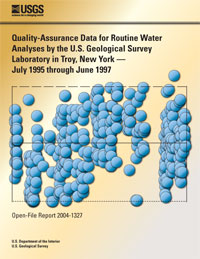 Quality-Assurance Data for Routine Water Analyses by the U.S. Geological Survey Laboratory in Troy, New York--July 1995 through June 1997
Quality-Assurance Data for Routine Water Analyses by the U.S. Geological Survey Laboratory in Troy, New York--July 1995 through June 1997
by Tricia A. Lincoln, Debra A. Horan-Ross, Michael R. McHale, and Gregory B. Lawrence
U.S. GEOLOGICAL SURVEY
Open-File Report 2004-1327
ABSTRACT
The laboratory for analysis of low-ionic-strength water
at the U.S. Geological Survey (USGS) office in Troy, N.Y.
analyzes samples collected by USGS projects in the Northeast.
The laboratory’s quality-assurance program is based on
internal and interlaboratory quality-assurance samples and
quality-control procedures developed to ensure proper sample
collection, processing, and analysis. For the time period
addressed in this report, the quality-assurance/quality-control
data were stored in the laboratory’s SAS data-management
system, which provides efficient review, compilation, and
plotting of quality-assurance/quality-control data. This report
presents and discusses samples analyzed from July 1995
through June 1997.
Quality-control results for 19 analytical procedures were
evaluated for bias and precision. Control charts show that data
from ten of the analytical procedures were biased throughout
the analysis period for either high-concentration or lowconcentration
samples but were within control limits; these
procedures were: acid-neutralizing capacity, total monomeric
aluminum, ammonium, calcium, chloride, dissolved organic
carbon, magnesium, nitrate (ion chromatography), nitrate
(colorimetric method), and sulfate. Four of the analytical
procedures were occasionally biased but were within control
limits; they were: fluoride, pH, silicon, and sodium.
Results from the filter-blank and analytical-blank
analyses indicate that all analytical procedures in which blanks
were run were within control limits, although values for a few
blanks were outside the control limits.
Sampling and analysis precision are evaluated herein
in terms of the coefficient of variation obtained for triplicate
samples in 14 of the 19 procedures. Data-quality objectives
(DQO’s) were met by at least 92 percent of the samples
analyzed in all procedures except acid neutralizing capacity
(80 percent of samples met objectives), total monomeric
aluminum (87 percent of samples met objectives), organic
monomeric aluminum (89 percent of samples met objectives),
and chloride (89 percent of samples met objectives). The data
are insufficient to evaluate the DQO’s for total aluminum.
Results of the USGS interlaboratory Standard Reference
Sample Program indicated acceptable data quality for most
constituents over the time period. The results of the P-sample
(low-ionic strength constituent) analysis indicated high data
quality with good ratings in all studies. The T-sample (trace
constituent) had unacceptable ratings in two studies, but
received satisfactory ratings in the others. The N-sample
(nutrient constituent) studies had an unacceptable rating in one
and an excellent rating in the other.
Environment Canada’s NWRI program results indicated
that at least 90 percent of the samples met data-quality
objectives in 9 of the 12 analyses; exceptions were calcium,
chloride, and silicon. Data-quality objectives were not met for
calcium samples in two NWRI studies, but all of the samples
analyzed were within control limits for the remaining studies.
Data-quality objectives were not met for 32 percent of samples
analyzed for chloride and 27 percent of samples analyzed for
silicon.
Results from blind reference-sample analyses indicated
that data-quality objectives were met by at least 90 percent of
the calcium, pH, potassium, and sodium samples. Data-quality
objectives were met by 77 percent of the chloride samples,
83 percent of the magnesium samples, and 80 percent of the
sulfate samples. There is insufficient data to evaluate the
specific conductance samples.
Citation: Lincoln, T.A., Horan-Ross, D.A., McHale, M.R., and Lawrence, G.B., 2005,
Quality-Assurance Data for Routine Water Analyses by the U.S. Geological Survey Laboratory in Troy, New York--July 1995 through June 1997:
U.S. Geological Survey Open-File Report 2004-1327, 23 p.
 [Full Report, Acrobat PDF
(2.7M)] --> Note: Large file size, recommend right-click "Save Target As..." to your PC, then double-click on local file to view in Acrobat Reader.
[Full Report, Acrobat PDF
(2.7M)] --> Note: Large file size, recommend right-click "Save Target As..." to your PC, then double-click on local file to view in Acrobat Reader.
[an error occurred while processing this directive]
|
